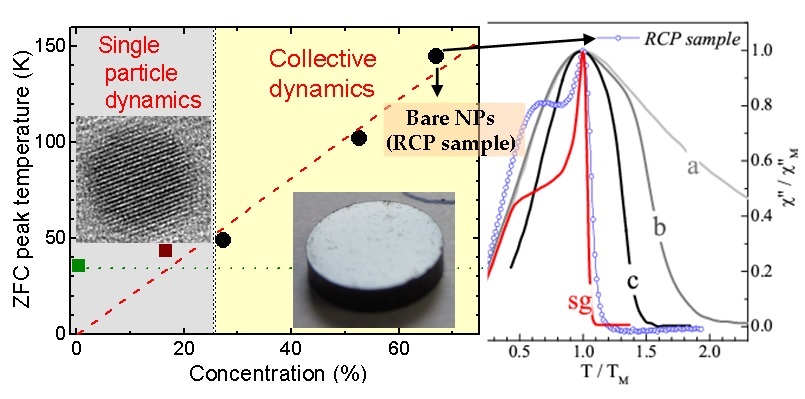Grupo de Materiales Magnéticos (GMM). Universidad de Castilla-La Mancha
Research line: Magnetic nanoparticle systems
Magnetic nanoparticle (NP) systems (with diameters of the order of 1-10 nm) are of great interest owing to many potential applications, in particular in biomedicine and information storage. The magnetic stability of such nanomagnets is determined by their size, anisotropy and interaction with other particles (as well as by possible internal interactions in particles with core-shell heterostructure, as described in the research field “Exchange anisotropy in nanostructured systems”).
In our group we study two types of NP systems: (a) nanogranular films prepared (in our laboratory) by codeposition of a beam of NPs (preformed in our “cluster source”) with a “matrix” material evaporated by sputtering in the deposition chamber, and (b) samples prepared with relatively large quantities (several milligrams) of highly monodisperse NPs of iron oxides (see TEM image below). With regard to the former type one is virtually free to choose the combination of materials used to form the NPs and matrix. Thus our preparation technique could be of interest to other groups (in the network) studying properties and phenomena further afield from nanomagnetism.

Several contributions by our group in the field of nanomagnetism include (see also our publication list): optimization of the giant magnetoresistance effect in nanogranular Co/Ag; evidence for the existence of indirect exchange (RKKY) interactions between NPs in certain conducting matrices; the enhancement of the magnetic stability temperature of NPs due to interparticle dipolar interactions; an evaluation of the relative importance of interparticle dipolar interactions versus superexchange in ferrimagnetic NPs; and very recently, the preparation of a model superspin glass, namely, a material with magnetic properties practically identical to those found in conventional spin glasses, but with the atomic spins substituted by NP superspins, and with exchange interaction replaced by classical dipolar interactions. The right panel of the upper figure shows how this latter system (of ferrimagnetic NPs randomly close packed – RCP – together) exhibits a phase transition as abrupt as in a canonical spin glass.











